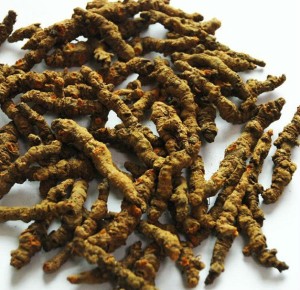Contents
Uses
Rhizoma coptidis is used for digestive disorders, parasite infections including leishmaniasis, and trichomoniasis, and a skin condition called psoriasis.
Benefits
1. It has a strong antibacterial effect on staphylococcus, streptococcus, pneumococcus, Vibrio cholerae, Bacillus anthracis, and dysentery bacterium except Shigella sonnei;
2. It also has an antibacterial effect on Klebsiella pneumoniae, Corynebacterium diphtheriae, Bacillus subtilis, Bordetella pertussis, yersinia pestis, brucellosis, and tuberculosis;
3. It has poor antibacterial effect on E. coli, Proteus, and Salmonella typhi;
4. The berberine can stimulate the heart, increase its contractility, and increase coronary blood flow when used in small dose and suppress the heart and weaken its contraction when used in large dose;
5. The berberine can reduce the heart rate of toad and stimulate the isolated atria of rabbit, guinea pig, and rat. It can also resist arrhythmia, have good cholagogic action, inhibit gastric secretion, arrest diarrhea, prevent acute inflammation, fight cancer, reduce tissue metabolism, and so on. And small dose of berberine can strengthen the excitability process in mouse’s cerebral cortex while large dose instead can strengthen the inhibition process;
6. Berberine and tetrahydroberberine can reduce myocardial oxygen consumption;
7. Berberine and its extracts have anti-ulcer effect.
Caution
There is not enough information to know if Rhizoma coptidis is safe in medicinal amounts. Rhizoma coptidis is UNSAFE in newborn infants.
Special Precautions & Warnings:
Children: Rhizoma coptidis is UNSAFE in children. It contains a chemical called berberine that can increase the amount of bilirubin in newborns. Bilirubin is a chemical released by the liver. Too much bilirubin can lead to permanent brain damage in newborns, especially in newborns born too early.
Pregnancy and breast-feeding: Rhizoma coptidis is UNSAFE during pregnancy. It contains a chemical called berberine that is thought to cross the placenta and may cause harm to the developing child. Brain damage due to too much bilirubin has developed in newborn infants exposed to berberine. Beginning research suggests pregnant women who take goldthread during the first three months of pregnancy increase the risk that their newborns will have birth defects affecting the central nervous system.
It’s also UNSAFE for breast-feeding mothers to take Rhizoma coptidis. Berberine and other harmful chemicals in Rhizoma coptidis can be transferred to the infant through breast milk.
Interactions
- Cyclosporine (Neoral, Sandimmune) interacts with Rhizoma coptidis
The body breaks down cyclosporine (Neoral, Sandimmune) to get rid of it. Goldthread might decrease how fast the body breaks down cyclosporine (Neoral, Sandimmune). This might cause there to be too much cyclosporine (Neoral, Sandimmune) in the body and potentially cause side effects. - Medications changed by the liver (Cytochrome P450 3A4 (CYP3A4) substrates) interacts with Rhizoma coptidis
Some medications are changed and broken down by the liver.Goldthread might decrease how quickly the liver breaks down some medications. Taking goldthread along with some medications that are broken down by the liver can increase the effects and side effects of some medications. Before taking goldthread, talk to your healthcare provider if you are taking any medications that are changed by the liver.Some medications changed by the liver include cyclosporine (Neoral, Sandimmune), lovastatin (Mevacor), clarithromycin (Biaxin), indinavir (Crixivan), sildenafil (Viagra), triazolam (Halcion), and many others.
Other names
Anemone groenlandica, Cankerroot, Chinese Coptis, Chinese Goldthread, Coptide, Coptide à Trois Feuilles, Coptide Chinois, Coptide du Groenland, Coptide Savoyane, Coptide Trifoliolée, Coptidis Rhizome, Coptis, Coptis chinensis, Coptis deltoidea, Coptis groenlandica, Coptis Rhizome, Coptis teeta, Coptis teetoides, Coptis trifolia, Golden Thread, Goldenthread, Huang Lian, Huanglian, Mouth Root, Racine Jaune, Rhizoma Coptidis, Savoyane, Tisavoyane Jaune, Yellowroot.
Reference
Source: WebMD, http://www.webmd.com/vitamins-supplements/ingredientmono-471-goldthread.aspx?activeingredientid=471&activeingredientname=goldthread
ChineseHerbsHealing, http://www.chineseherbshealing.com/coptis-root/

